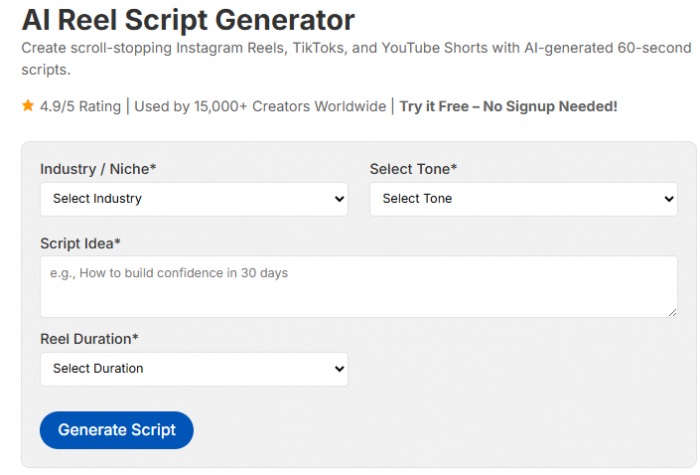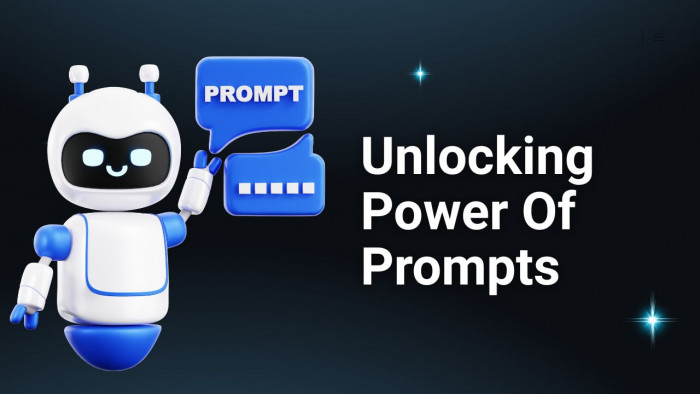Table of Content
- 1. Explainer Video Script Prompt
- 2. Storytelling Script Prompt
- 3. Hook-First Script Prompt
- 4. Problem–Solution Script Prompt
- 5. Listicle Script Prompt
- 6. Authority Script Prompt
- 7. FAQ Script Prompt
- 8. Trend-Jacking Script Prompt
- 9. CTA-Driven Script Prompt
- 10. Emotional Appeal Script Prompt
- Final Thoughts
Video marketing is no longer optional—it’s essential. As Forbes highlights, video is the most powerful medium for building trust, driving sales, and engaging audiences. With global digital video ad spend reaching record highs according to Statista, creators and brands alike are prioritizing video to capture attention in a crowded digital landscape.
Yet, one roadblock remains: scripting. Coming up with engaging scripts is time-consuming, and that’s where AI steps in. Tools like the Reel Script Generator by SmartPostly, when paired with well-crafted prompts, can generate polished, ready-to-record scripts for YouTube Shorts, Instagram Reels, TikTok, and more.

Here are 10 AI prompts you can use to quickly create scripts that resonate, educate, and inspire.
1. Explainer Video Script Prompt
Prompt:
“Write a 60-second Instagram Reel script that explains how compound interest works.
Hook: Start with a surprising fact (‘Did you know $100 today could become $10,000?’).
Body: Explain what compound interest is, why time matters, and use one analogy (like planting a tree that grows fruit).
Tone: Conversational and simple.
Closing: Encourage viewers to follow for more finance tips.”
The advantage of this style: Explainer videos turn complex concepts into bite-sized knowledge, making them highly shareable on short-form platforms.
2. Storytelling Script Prompt
Prompt:
“Write a 90-second TikTok script teaching the value of saving through a story.
Character: Sarah, 25, in her first job.
Conflict: She spends her paycheck too quickly.
Resolution: She adopts the 50/30/20 rule.
Closing: ‘If Sarah can do it, so can you.’
Tone: Relatable, humorous.”
How this structure performs: Storytelling scripts foster emotional connection, which keeps audiences watching longer and encourages shares.
3. Hook-First Script Prompt
Prompt:
“Create a 30-second YouTube Shorts script about sleep deprivation.
Hook: Use a shocking stat (‘1 in 3 adults don’t get enough sleep’).
Context: Briefly explain the health consequences.
Takeaway: Share one quick hack—turn off devices 30 minutes before bed.
CTA: Ask viewers to follow for better sleep tips.”
The benefit of this approach: Strong hooks immediately capture attention, ensuring people don’t scroll away in the first 3 seconds.
4. Problem–Solution Script Prompt
Prompt:
“Write a 45-second Instagram Reel about staying focused while studying.
Problem: ‘You sit down to study… and 5 minutes later, you’re scrolling TikTok.’
Solution: Share 3 quick steps (Pomodoro timer, silent phone, 5-min breaks).
Closing: Reassure viewers (‘You don’t need to be perfect, just consistent’).
CTA: ‘Save this video for your next study session.’”
Why audiences respond: Viewers feel seen when problems they face daily are acknowledged first, making the solution more persuasive.
5. Listicle Script Prompt
Prompt:
“Draft a 60-second TikTok script titled ‘5 Skincare Hacks You Need to Try.’
Deliver each hack in under 8 seconds, numbered.
Quick recap: Summarize all tips in 5 seconds.
CTA: ‘Follow for more skincare secrets.’
Tone: Fast, casual, upbeat.”
The impact of this prompt: Short, numbered tips are bingeable and replay-worthy, boosting engagement on platforms like TikTok.
6. Authority Script Prompt
Prompt:
“Write a 75-second LinkedIn video script on why small businesses need cybersecurity.
Start: ‘60% of small businesses shut down within 6 months of a cyberattack.’
Body: Explain why they’re vulnerable and what steps can help.
Closing: ‘Prevention is cheaper than recovery—start today.’
Tone: Confident, professional.”
Why this format engages: Authority-driven scripts backed by statistics (as noted in God of Prompt AI) build credibility and position you as an expert.
7. FAQ Script Prompt
Prompt:
“Write a 45-second YouTube Shorts script answering: ‘Do you need a degree to become a software developer?’
Intro: Restate the question.
Answer: ‘No—you can start with online courses and projects.’
Example: Compare coding to learning a language (practice > formal schooling).
Closing: ‘Subscribe for more coding FAQs.’
Tone: Supportive, direct.”
The advantage of this style: FAQ scripts target search intent, making them ideal for discoverability on YouTube.
8. Trend-Jacking Script Prompt
Prompt:
“Write a 30-second TikTok script about fitness using a trending meme audio.
Scenario: Skipping leg day in a funny exaggeration.
Transition: Tie back to why leg day matters.
Tip: Share one strength-building exercise.
CTA: ‘Tag a friend who always skips leg day.’
Tone: Witty, aligned with TikTok humor.”
How this structure performs: Trend adoption, as Team-GPT explains, helps creators ride existing virality while staying niche-relevant.
9. CTA-Driven Script Prompt
Prompt:
“Write a 45-second Instagram Reel introducing the Pomodoro method.
Intro: ‘Want to finish tasks twice as fast?’
Body: Explain the 25/5-minute method in simple terms.
CTA: ‘Download my free productivity planner today.’
Tone: Energetic, persuasive.”
The benefit of this approach: Scripts with a direct CTA move viewers from passive watchers to active participants—subscribers, leads, or buyers.
10. Emotional Appeal Script Prompt
Prompt:
“Write a 90-second motivational video script about overcoming failure.
Opening: Relatable hook (‘Failure isn’t the end—it’s the beginning.’).
Story: Share one short example of someone bouncing back.
Closing: Inspirational line (‘Your story is still being written.’).
Tone: Uplifting, empathetic.”
Why audiences respond: Emotional storytelling inspires loyalty and higher shares, especially for personal brands and non-profits.
Final Thoughts
Creating videos is no longer just about hitting record—it’s about telling a story that resonates. A great script is the backbone of that story, and with the right AI prompts, you can transform raw ideas into content that feels polished, engaging, and purposeful.
These prompts aren’t just shortcuts; they’re frameworks to help you connect with your audience on a deeper level—whether that means educating, entertaining, or inspiring them. When you approach video scriptwriting this way, you stop worrying about “what to say” and start focusing on how to say it in a way that truly sticks.
The future of content belongs to those who can blend creativity with strategy. And by mastering AI-driven prompts, you’re giving yourself the freedom to focus on the bigger picture: building trust, sparking emotion, and creating videos that people remember.


